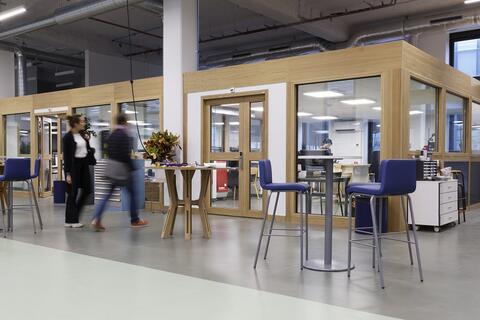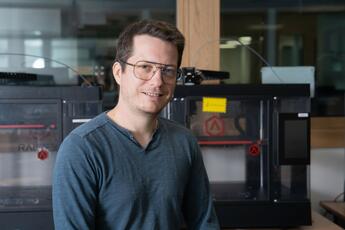
The fablab, a place of creation and innovation
An interview with Stéphane Muller, fablab manager at Sorbonne University

Responsible for the fablab prototyping space, Stéphane Muller shows us the riches that this place offers to the entire university community in terms of innovation, experimentation and manufacturing.
Can you tell us about the fablab, its history and its new premises?
Stéphane Muller: The fablab was born in 2014, from a crazy idea of 2 academic researchers, Christian Simon and Vincent Dupuis, who wanted to create a place where students could finally develop all their ideas. Innovate, experiment, touch, manufacture, prototype, all within the university. In 2016, Christophe Bailly joined the project and added a space dedicated to biology to the fablab: the greenlab.
What started with just a few 3D printers and a laser cutter in a 70 square-meter room, has transformed into a 700 square-meter space dedicated to prototyping and a 120 square-meter space dedicated to biology and chemistry.
What can you find there and what services are offered?
S. M.: The fablab is a large machine park that offers free access to prototype and manufacture almost anything and everything! In the prototyping area, you will find several rooms on different themes: 3D printing, cutting, electronics and carpentry. As for the biology-chemistry area, it offers all the equipment necessary to do plant biology and chemistry, in particular molding (silicone, epoxy, polyurethane, and more).
But the fablab is above all a place to exchange, where the student community from all sectors and the community of academic researchers come together. We share our knowledge, we help each other, we experiment and above all we learn by doing it ourselves.
The fablab is made up of three directors, an administrative manager, a general manager, a reception and communications manager, five fab managers and around fifty student jobs. This fablab team supports users on their projects. As part of the service, it can also help them design or create a prototype for a laboratory. We also organize training, workshops open to the entire university community and events such as “repair cafés” or hackathons.
Which audiences can access it?
S. M.: The fablab is open to the entire Sorbonne University community - students, teachers, researchers, technical and administrative staff...
We also welcome companies, startups and associations.
Which disciplines may find this space interesting?
S. M.: All disciplines are welcome and may potentially be interested. The field of possibilities is vast. Scientific and technical disciplines are particularly well represented of course, but art, design, medicine or literature students can also find interesting projects to carry out there.
The fablab is a tool that can be used in many different ways. For example, we printed a patient's heart in flexible resin for surgeons. An artist made engravings of mathematical curves. Geologists have reproduced a 3D relief on wood. INSPE students have created objects linked to poetry... the only limit is imagination!
Can you give us some examples of projects carried out by the fablab?
S. M.: For example, the Air Citizen participatory science project, the aim of which is to enable citizens to actively measure the quality of their immediate environment and in particular the air around them. There is also the Open Radiation participatory science project, which is a platform allowing everyone to report radioactivity measurements via an open source Geiger counter.
The fablab also offers training, right?
S. M.: Absolutely, in addition to workshops to train in the basics of certain techniques (3D printing and modeling, electronics with Arduino, etc.), the fablab offers Fab Academy training. This is training that takes place simultaneously in hundreds of fablabs around the world. Led by Neil Gershenfeld, professor at MIT and inventor of the fablab concept, it takes place every year between January and June and allows you to learn all the prototyping techniques used at the fablab. Each week the students must carry out and document a different project: scan an object, make a mold, make a piece of furniture, make an electronic circuit then program it...
The training ends with the presentation of a final project using as many of the techniques learned over the five months as possible.
What is your background and what role do you have as fablab manager?
S. M.: I have had the chance to study and work in several fields. I started in telecommunications and computer networks, then I did technical translation and multimedia educational engineering before finally becoming a fabmanager.
As a fabmanager, my role is to support users on their projects by guiding them in their approach or by teaching them how to use the machines. I provide services for several laboratories by manufacturing certain parts for them. I take care of machine maintenance and stock management. I am also a Fab Academy instructor. The technologies that we use at the fablab are constantly evolving, so we must also monitor and continue to train on the new techniques, new software and new machines that are coming out.
Discover the fablab in pictures
Open hours and locations
The prototyping space is located in the Esclangon building, Jussieu level. It is open Mondays, Tuesdays, Thursdays and Fridays from 2 p.m. to 6:30 p.m.
The biology-chemistry space is located at bar 43-44 on the 2nd floor. It is open Mondays, Tuesdays, Wednesdays and Fridays from 2 p.m. to 6:30 p.m.




